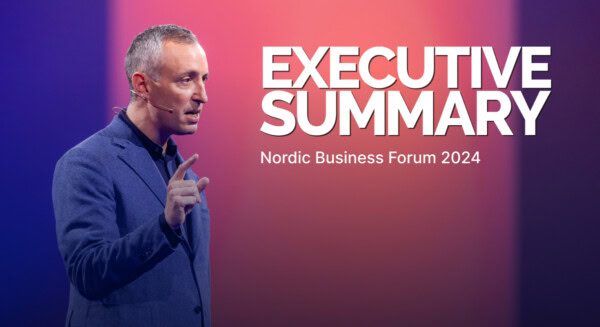17Oct2024
If you have a problem to solve, do you look to the sky? Cast your eyes down to the earth? Or reach out to those nearby? According to renowned management professor Morten Hansen, businesses need to embrace the skill of horizontal leadership to compliment the vertical structures that, in isolation, stifle innovation and success.
The Problem with Vertical Leadership
Morten cites the failure of Sony Connect—a long-forgotten iPod competitor—as an example of how sole reliance on vertical leadership fails to deliver innovation. Although Sony seemingly had everything they needed, an organizational structure composed of five separate, siloed business units effectively made it impossible for the needed resources to be pooled to deliver this new product. In contrast, Apple’s horizontal approach was able to quickly align internal and external teams around the project, resulting in the groundbreaking success of the iPod.
Vertical leadership, Morten explained, uses formal authority over a unit to ensure commands flow up and down. While vertical leadership is necessary for running a business, it fails when innovation and large-scale collaboration are required.
The Rise of Horizontal Leadership
Morten argued that horizontal leadership is crucial for modern businesses facing globalization, specialization, and rapid technological changes.
“More expertise is spread out across the world; we need to stitch that together.”
Horizontal leadership thrives when collaboration becomes essential for innovation, involving people from different teams, companies, or even external partners to achieve common goals.
According to Morten, horizontal leadership requires three key actions: envisioning, enlisting, and enacting. Leaders must first envision cross-functional opportunities, enlist others to support these initiatives without having formal authority, and finally, enact these ideas into results. Each of these steps demands specific skills that go beyond the traditional vertical model of leadership.
Envisioning: Seeing beyond Silos
Envisioning is the ability to look beyond one’s silo, identify opportunities across the broader organizational landscape, and create a vision for initiatives that benefit the entire company. Morten illustrated this with a story about a consulting firm’s sales team bidding for an SAP implementation project at Coca-Cola. They had two choices: either work in isolation or reach out to colleagues. Through statistical analysis, Morten’s research showed that collaborating with other offices was beneficial only when the internal sales team lacked the necessary expertise to complete the bid by themselves. Otherwise, collaboration merely slowed them down.
The lesson? Not all collaboration is beneficial, and bad collaboration is worse than none at all. Morten emphasized that there must be a compelling business case for engaging in horizontal leadership. “Complementary expertise is key,” he noted, using Procter & Gamble as an example of a company that excels at combining different areas of expertise to create innovative products.
Enlisting: Leading without Authority
Perhaps the most challenging aspect of horizontal leadership, Morten explained, is the ability to enlist others without formal authority. Leaders must influence, inspire, and motivate people to contribute time and resources to initiatives without the power to mandate participation. Morten shared four common barriers to enlisting others in collaborative efforts:
- The “not invented here” barrier: Teams are often reluctant to accept ideas from external sources, driven by a belief that their own ideas are superior.
- The hoarding barrier: People may withhold resources, reluctant to share expertise or data due to competitive internal dynamics, as seen in Sony’s case.
- The search barrier: It can be difficult to locate the right expertise or resources, especially in large, dispersed organisations.
- The teamwork barrier: Collaborating with teams that have never worked together can lead to confusion, miscommunication, and inefficiency.
Enacting: Making Things Happen
The final step in horizontal leadership is enacting—taking action and driving results. Morten pointed out that enacting requires leaders to unite teams around a shared goal that inspires people to achieve it. He gave the example of the U.S. moon landing, which rallied an entire nation around a clear, compelling goal: “Land a man on the moon and return him safely to Earth before the decade ends.”
Disagree and Commit
Morten concluded by highlighting the importance of conflict resolution in horizontal leadership. In collaborative efforts, disagreements are inevitable, but they must be managed productively. Morten discussed the concept of “disagree and commit,” where teams engage in healthy debates, challenge ideas rigorously, and then commit to the final decision once it has been made.
“Disagreement without commitment leads to chaos, and commitment without disagreement leads to bad decisions.”
Key points
- Not all collaboration is good: Collaboration should only occur when there is a clear business case and when complementary expertise can drive innovation. Bad collaboration is worse than none at all.
- Influence without authority: Horizontal leaders must master the art of enlisting others without formal power, inspiring and motivating people through influence, not mandates.
- Overcoming barriers to collaboration: To successfully practise horizontal leadership, leaders must tackle barriers like “not invented here,” resource hoarding, search inefficiencies, and teamwork challenges.
- Unifying goals drive success: A compelling, shared goal is essential to unite cross-functional teams and motivate them to work together toward a common purpose.
- Healthy conflict is essential: Leaders must facilitate open-ended discussions, encourage dissenting views, and ensure that disagreements are resolved through commitment to the final decision.
Questions for Reflection
- How can your organization better identify when collaboration is truly beneficial, and avoid engaging in “bad” collaboration?
- What strategies can you implement to inspire and enlist others in horizontal leadership initiatives without relying on formal authority?
- What are the biggest barriers to collaboration in your organization, and how can you begin addressing them today?
- Do you have compelling, unifying goals that align cross-functional teams in your organization? How can you develop clearer, more inspiring goals?
- How can your team ensure healthy conflict resolution while maintaining commitment to final decisions?


